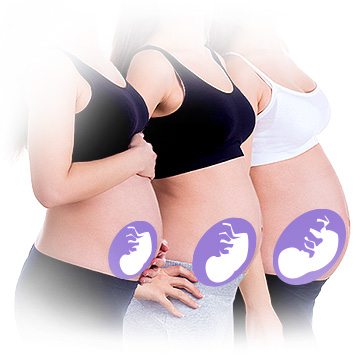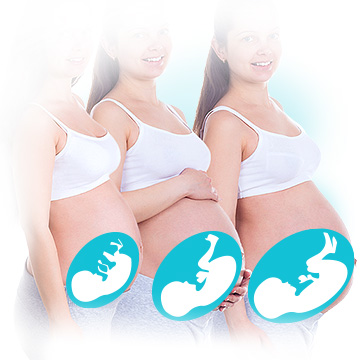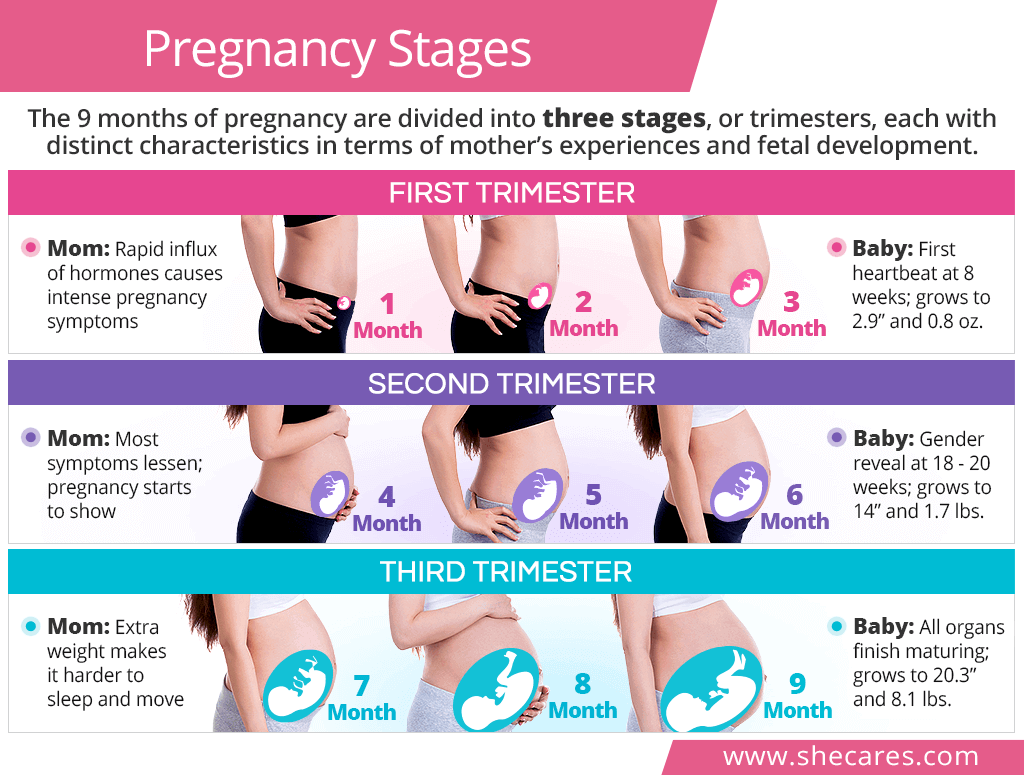First Pregnancy Trimester (Weeks 1-12)
First Trimester Mother

During the first trimester, there is a rapid influx of reproductive hormones, like human chorionic gonadotropin, estrogen, and progesterone, aimed at preparing the uterus for implantation of the fertilized egg and supporting fetal development in its primary stages.
Consequently, a woman is likely to experience early pregnancy symptoms, including morning sickness, fatigue, or breast tenderness. In this time, she will have her first prenatal visit to rule out ectopic pregnancy, estimate baby due date, discuss the increased risk of miscarriage in early pregnancy, and learn the best ways to have a healthy pregnancy.
First Trimester Baby
In the first trimester, the baby moves through all stages of fetal development: germinal (weeks 2-4), embryonic (weeks 5-9), and fetal (starting at week 10 and continuing through the second and third trimesters until birth). Also, the baby's main organs begin developing, and he or she grows from measuring just a quarter of an inch to 2.9 inches and 0.8 ounces, on average. The first heartbeat can be detected as early as the eighth pregnancy week.
Also, during the first month of pregnancy, the neural tube is formed. To prevent defects during this essential time, prenatal vitamins with at least 400mcg of folic acid are recommended as soon as a woman receives pregnancy confirmation, or preferably at least one month before conceiving.2
Second Pregnancy Trimester (Weeks 13-27)
Second Trimester Mother

In the second trimester, most women report lessening of pregnancy symptoms, though they can experience various body aches and dental problems as their bodies strive to support the developing fetus. Their gradually growing baby bump starts showing, and a decreasing risk of miscarriage prompts them to share the news with their friends and family.
Between the 18th and 20th weeks, a pregnancy ultrasound can reveal the baby's gender. Depending on the results of prenatal tests or certain risk factors, women might be recommended genetic testing during pregnancy, like amniocentesis, which determines whether the baby has some form of a genetic condition or birth defects.
Second Trimester Baby
The second trimester baby is busy in the womb as he or she grows from being just 3.4 inches and 1.5 ounces to measuring 14 inches and weighing 1.7 pounds. Women will also feel the first baby movement, called quickening, around the fifth pregnancy month. Besides moving, the fetus will also start yawning, sucking on a thumb, and hear and respond to sounds from the outside.
Also during these pregnancy months, the baby's skin is covered in soft, fine hair called lanugo as well as a protective coating vernix caseosa to shield it from the effects of amniotic fluid. Passing the 23rd week of pregnancy, the chances of survival outside the womb are increasing, and a premature baby can often survive in the intensive care unit.
Third Pregnancy Trimester (Weeks 28-40)
Third Trimester Mother

In the third trimester, a woman feels the heaviness of carrying extra weight more than before. In fact, her expected pregnancy weight gain in the last three months is 20 pounds, on average.
Consequently, expectant mothers typically struggle with back pain as pelvic ligaments relax before labor, swollen feet as the body retains water, and breathing as the uterus pushes against her diaphragm. They might also experience Braxton Hicks contractions, practice contractions of uterine muscles before the actual childbirth. Women will also be closely monitored for signs of preeclampsia, preterm birth, and other pregnancy complications of the last trimester.
Third Trimester Baby
The third trimester baby is growing very rapidly, gaining weight, and maturing his or her brain and lungs. The baby's movement and kicks are now energetic and frequent and can be counted to monitor fetal well-being. In the ninth pregnancy month, the baby descends into the pelvis and takes on vertex position (head towards the birth canal) to facilitate the delivery.
A “full term” pregnancy is one that lasts between 39 weeks and 0 days to 40 weeks and 6 days, although it is normal for delivery to take place between the 37th and 42nd weeks.3
Key Takeaways
By convention, the seemingly long nine months of being pregnant are divided into three distinct pregnancy stages, called trimesters. Starting from the first day of a woman's last menstrual period until the end of week 12 is the first trimester, during which a woman might experience the most notorious pregnancy symptoms, like morning sickness or fatigue, and the baby's first heartbeat can be detected. The following trimester tends to be easier on a woman as many of the initial symptoms lessen, but it is very busy for the baby. His or her major organs continue maturing, including the reproductive organs, and gender can be revealed. During the third trimester, a woman feels the burden of extra weight, while the baby rapidly gains weight and takes on delivery position. The three pregnancy stages end with childbirth, which typically occurs between the 37th and 42nd weeks.
Sources
- American Pregnancy Association. (n.d.). Pregnancy Week by Week. Retrieved May 2, 2019 from https://americanpregnancy.org/week-by-week/
- Better Health Channel. (2012). Pregnancy - week by week. Retrieved May 2, 2019 from https://www.betterhealth.vic.gov.au/health/HealthyLiving/pregnancy-week-by-week
- Cleveland Clinic. (2014). Fetal Development: Stages of Growth. Retrieved May 2, 2019 from https://my.clevelandclinic.org/health/articles/7247-fetal-development-stages-of-growth
- Embryology. (2019). Fetal Development. Retrieved May 2, 2019 from https://embryology.med.unsw.edu.au/embryology/index.php/Fetal_Development
- Medline Plus. (2019). Fetal Health and Development. Retrieved May 2, 2019 from https://medlineplus.gov/fetalhealthanddevelopment.html
- National Child & Maternal Health Education Program. (n.d). Full-Term Pregnancy. Retrieved May 2, 2019 from https://www1.nichd.nih.gov/ncmhep/initiatives/know-your-terms/Pages/moms.aspx
- Office on Women's Health. (2019). Stages of pregnancy. Retrieved May 2, 2019 from https://www.womenshealth.gov/pregnancy/youre-pregnant-now-what/stages-pregnancy
- Planned Parenthood. (n.d.). Pregnancy Month by Month. Retrieved May 2, 2019 from https://www.plannedparenthood.org/learn/pregnancy/pregnancy-month-by-month
Footnotes:
- Better Health Channel. (2014). Baby due date. Retrieved September 8, 2021 from https://www.betterhealth.vic.gov.au/health/healthyliving/baby-due-date
- CDC. (2021). Folic Acid. Retrieved September 8, 2021 from https://www.cdc.gov/ncbddd/folicacid/about.html
- March of Dimes. (2018). What is full term? Retrieved September 8, 2021 from https://www.marchofdimes.org/pregnancy/what-is-full-term.aspx
